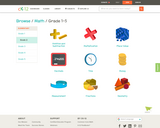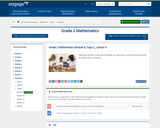
Name the 2-D shapes
- Subject:
- Mathematics
- Material Type:
- Interactive
- Author:
- Donna Currie
- Date Added:
- 06/08/2021

Name the 2-D shapes

This is a task from the Illustrative Mathematics website that is one part of a complete illustration of the standard to which it is aligned. Each task has at least one solution and some commentary that addresses important asects of the task and its potential use. Here are the first few lines of the commentary for this task: * Color the inside of all the triangles blue. * Color the inside of all the quadrilaterals red. * Color the inside of all the pentagons orange. * Color...

This parent guide supports parents in helping their child at home with the 2nd Grade Math content. Within the folder you will access Parent Guide PDFs in FIVE Languages: Arabic, English, Hindi, Spanish, and Vietnamese to help on-going communication with caregivers.

This resource accompanies our Rethink 2nd Grade Math Geometry unit. It includes ideas for use, ways to support exceptional children, ways to extend learning, digital resources and tools, tips for supporting English Language Learners and students with visual and hearing impairments. There are also ideas for offline learning.

This short video and interactive assessment activity is designed to teach second graders an overview of lines, curves, vertices, and sides of 2d shapes.

Students use blocks to build a design from a written description. Try various descriptions to achieve the correct design.

This lesson builds on the understanding of loops from previous lessons and gives students a chance to be truly creative. This activity doubles as a debugging exercise for extra problem-solving practice.

Students will recognize and sort 2 dimensinal shapes based on their attributes using a tree map.

The Family Letters are intended to be sent home at the beginning and middle of the cluster. They explain big ideas of the cluster using family-friendly language. Families can also find tips for working with their children at home, digital games, videos, and books. This file contains both English and Spanish versions of the Family Letters.

An interactive applet and associated web page that demonstrate the properties of a cube. A 3-D cube is shown in the applet which can be interactively manipulated using the mouse. Research has shown that some younger students have difficulty visualizing the parts of a 3D object that are hidden. To help with this, the student can rotate the cube in any axis simply by dragging it with the mouse. It can also be 'exploded' - where a slider gradually separates the faces to reveal the ones behind. The cube can also be made translucent so you see through it to the other side. Applet can be enlarged to full screen size for use with a classroom projector, and printed to make handouts. This resource is a component of the Math Open Reference Interactive Geometry textbook project at http://www.mathopenref.com.

Ck-12's Grade 2 Elementary Math is a series of videos and interactive videos designed to teach basic math concepts to 2nd graders. Concepts covered include Addition and Subtraction, Multiplication, Place Value, Decimals, Time, Fractions, Money, Measurement, and Geometry.

This short video and interactive assessment activity is designed to teach second graders about counting vertices and sides in various shapes.

G2M8: Time, Shapes, and Fractions as Equal Parts of Shapes. Contains 16 Lessons.

Students use geoboards to make a quadrilateral. Students copy their quadrilateral onto geoboard paper and record as many different quadrilaterals as they can and tell how the quadriaterals are alike and different.

Do you know the difference between circles and spheres? Hexagons and Pentagons? Discover shapes in real-life scenes and shape up your knowledge of geometry with ABCya's Get in Shape!

In this lesson, students combine shapes to create a composite shape; create a new shape from composite shapes.

In this lesson, students partition circles and rectangles into equal parts, and describe those parts as halves, thirds, or fourths.

This short video and interactive assessment activity is designed to teach second graders an overview of ellipses, trapezoids, rhombi, and polygons.

This short video and interactive assessment activity is designed to teach second graders about counting the number of different 2d shapes in a composite figure.

Students collect data within their school about current social issues and create graphs to display and analyze the data. Students simultaneously read and write fables based on the prevalent social issues. Students then make 2D illustrations for their fables and practice reading their stories aloud with fluency. The culminating event is a Meet the Author showcase for parents to hear the stories and get autographs from the new authors.